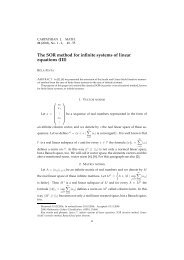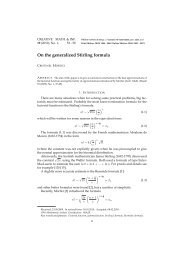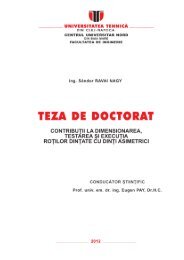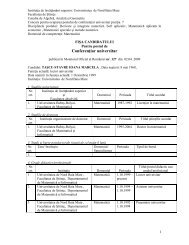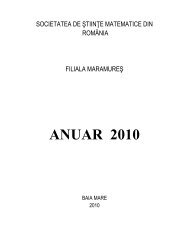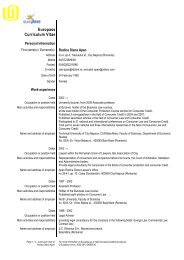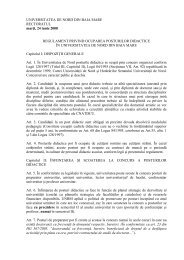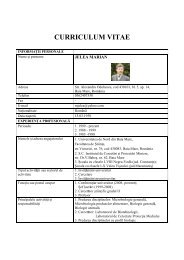Vol 3 (1) 2011 - UBM :: Departamentul de Chimie-Biologie
Vol 3 (1) 2011 - UBM :: Departamentul de Chimie-Biologie
Vol 3 (1) 2011 - UBM :: Departamentul de Chimie-Biologie
You also want an ePaper? Increase the reach of your titles
YUMPU automatically turns print PDFs into web optimized ePapers that Google loves.
Carpathian Journal of Food Science and Technology <strong>2011</strong>, 3(1), 39-43<br />
pulp having a total soluble solids (TSS)<br />
content of 4.5% was put in an open pan and<br />
the spices were wrapped in a muslin cloth<br />
and dipped into the juice. Onion, ginger and<br />
garlic were also pulped and ad<strong>de</strong>d to the<br />
juice. The ketchup was heated on a low<br />
flame with constant stirring till a final TSS<br />
of 28% was obtained. Then sodium benzoate<br />
(750 ppm) was ad<strong>de</strong>d as a preservative. TSS<br />
of tomato juice and ketchup was measured<br />
with the help of Hand Refractometer. Two<br />
different hydrocolloids namely guar gum<br />
and xanthan gum were ad<strong>de</strong>d to the ketchup<br />
at different levels of 0.25 % and 0.5% and<br />
combination of guar and xanthan gum at<br />
0.50%, just before the end point. The<br />
hydrocolloids were pre-blen<strong>de</strong>d with the<br />
sugar and salt and then ad<strong>de</strong>d to the ketchup<br />
during the final stages of cooking. The<br />
ketchup was filled hot in glass bottles, sealed<br />
with crown corks and stored.<br />
Table 1. Recipe used for the preparation of<br />
tomato ketchup<br />
Ingredients Quantity used<br />
Tomato juice<br />
1 Kg<br />
Sugar<br />
80 g<br />
Salt<br />
10 g<br />
Onions<br />
3.0 g<br />
Ginger<br />
6.0 g<br />
Garlic<br />
6.0 g<br />
Cloves (headless)<br />
0.3 g<br />
Cinnamon<br />
0.3 g<br />
Red chili pow<strong>de</strong>r<br />
1.5 g<br />
Black pepper pow<strong>de</strong>r 0.002 g<br />
Acetic acid (99.5%) 2.5 mL<br />
2.1. Analysis of tomato ketchup<br />
Moisture content of the ketchups was<br />
<strong>de</strong>termined by AOAC [11]. Total soluble<br />
solid (TSS) was measured by Hand<br />
Refractometer. The ability of the gums to<br />
hold water in the ketchup was also<br />
measured. Tomato ketchup (20 g) was taken<br />
in a centrifuge tube and then centrifuged at<br />
5000 rpm for 10 min. The supernatant was<br />
40<br />
discar<strong>de</strong>d and the remaining ketchup was<br />
weighed. Serum loss was calculated<br />
according to the following equation [9]:<br />
weight of the serum removed<br />
Serum Loss,% =<br />
⋅ 100<br />
weight of ketchup<br />
(1)<br />
Reduction in serum loss in the<br />
ketchup samples was also calculated<br />
according to the following equation:<br />
%Reduction in serum loss =<br />
SR<br />
control<br />
− SR<br />
sample<br />
100<br />
SR<br />
control<br />
(2)<br />
where SR control and SR sample is the serum loss<br />
in control ketchup and serum loss in sample<br />
ketchup, respectively.<br />
Viscosity analysis of the ketchup<br />
samples were carried out with Brookfield<br />
Viscometer (RV mo<strong>de</strong>l) at 25ºC and spindle<br />
no. 5 at 20 rpm. Yield of the ketchups was<br />
also calculated. All the results were obtained<br />
using samples from three different batches.<br />
2.2. Sensory evaluation of tomato ketchup<br />
The sensory attributes like taste,<br />
color, appearance, aroma, texture and overall<br />
acceptability of the product were <strong>de</strong>termined<br />
using a taste panel consisting of 10 panelists.<br />
The ratings were on a 9 point hedonic scale<br />
ranging from 1 (dislike extremely) to 9 (like<br />
extremely).<br />
2.3. Statistical analysis<br />
The experimental data collected was<br />
analyzed for significant differences with the<br />
help of analysis of variance (ANOVA)<br />
conducted using SPSS 16.0 software.<br />
3. Results and discussions<br />
Chemical composition of the tomato<br />
pulp used was investigated and has been<br />
presented in the Table 2.



